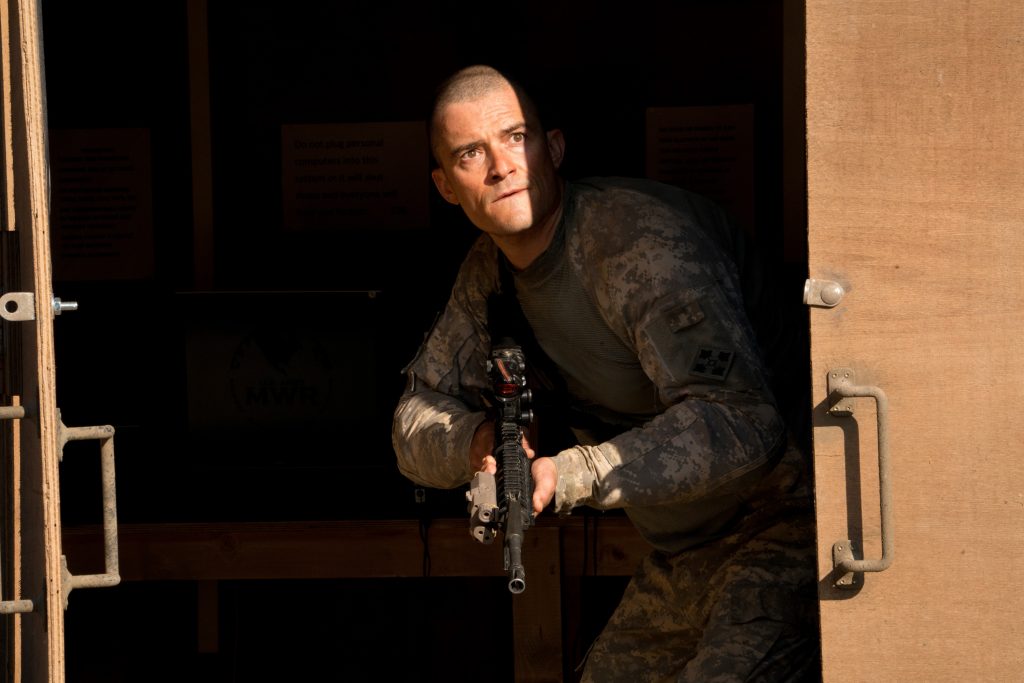April 22, 2023
by Carla Hay

Culture Representation: Taking place in 2018, in Afghanistan and in the United States, the action film “Guy Ritche’s The Covenant” features a cast of white and Middle Eastern characters (with a few African American, Latinos and East Asians) representing the working-class and middle-class and who are connected in some way to the U.S. war in Afghanistan.
Culture Clash: U.S. Army master sergeant John Kinley, who has his life saved by an Afghan interpreter, goes on a mission to rescue the interpreter and the interpreter’s family from war-torn Afghanistan and to keep the U.S. government’s promise to give U.S. visas to the family.
Culture Audience: “Guy Ritchie’s The Covenant” will appeal primarily to people who are fans of filmmaker Guy Ritchie, the movie’s headliners, and stories about noble rescue missions during a war.

“Guy Ritchie’s The Covenant” offers an overly simplistic portrayal of an American rescue mission in Afghanistan. However, this action flick has solid performances and capably shows the importance of interpreters during war. The movie is a mixed bag of questionable scenarios that look very fabricated for a movie and realistic depictions of the emotions and motivations for these actions.
Guy Ritchie tends to write and direct action movies that have a lot of wisecracking banter among the characters. Compared to those other films, “Guy Ritchie’s The Covenant” is a departure for him, since it’s a deadly serious film that is inspired by harrowing situations from the 2001 to 2021 war that the U.S. waged in Afghanistan. (The movie, which takes place in 2018, was actually filmed in Spain.) In addition to directing “Guy Ritchie’s The Covenant” and being one of the movie’s producers, Ritchie co-wrote the screenplay with Ivan Atkinson and Marn Davies.
The rescue mission part of the story doesn’t happen until the last third of the movie. Until then, viewers get to know the two central characters when the movie shows how these two men bonded during the horrors of war. John Kinley (played by Jake Gyllenhaal), who is American, is a master sergeant for the U.S. Army. Ahmed Abdullah (played by Dar Salim), who is Afghan, currently works as an interpreter for the U.S. military. Other things about Ahmed’s background are eventually revealed and cause people to trust or mistrust Ahmed. John and Ahmed are both in their 40s and happily married to loyal wives.
The beginning of “Guy Ritchie’s The Covenant” takes place in Afghanistan, where John is leading a squad of staff sergeants who are tasked with finding explosives from the Taliban. It’s a tight-knit unit that has overall good camaraderie. The members of this specialist unit under John’s leadership are Joshua “JJ” Jung (played by Jason Wong); Tom “Tom Cat” Hancock (played by Rhys Yates); Eduardo “Chow Chow” Lopez (played by Christian Ochoa); Charlie “Jizzy” Crow (played by Sean Sagar); and Jack “Jack Jack” Jackson (played by James Nelson Joyce); and Steve Kersher (played by Bobby Schofield), the youngest sergeant in the group.
Because this is a brutal war, not everyone will make it out alive. The unit has an interpreter named Kalan (played by Walid Shahalami), who is killed by a hidden bomb. John chooses Ahmed from a group of local interpreters to replace Kalan. John hired Ahmed without knowing much about him, except that Ahmed can speak four langauges, and Ahmed needs the money for this interpreter job. Ahmed also has a brother named Ali (played by Damon Zolfaghari), who has a pivotal role in the story.
There are the predictable clashes between Ahmed (who has a tendency to defy John’s orders) and John (who has a tendency to not trust Ahmed’s information over the U.S. military’s intel), but Ahmed and John eventually learn to trust each other. Later, it’s revealed that Ahmed decided to help the U.S. government out of revenge for the Taliban killing his son years earlier, and because the interpreter job comes with the promise that Ahmed and his wife Basira (played by Fariba Sheikhan) can get U.S. visa for themselves and their unborn child. Basira is pregnant at the beginning of the story. The Taliban considers Ahmed to be a traitor, so he’s also a target for murder by the Taliban.
Through a series of events, John and Ahmed are separated from the rest of the unit. Ahmed saves John’s life on multiple occasions. After John gets serious injuries, Ahmed carries a barely conscious John in a cart on a dangerous trek through the mountains. This trip results in John being rescued and sent back to the U.S., but Ahmed is left behind in Afghanistan. Ahmed gets put on the Taliban’s “most wanted” list, so he and his family go into hiding. John is also put on the Taliban’s “most wanted” list.
The fact that John makes it home alive because of Ahmed’s help is not spoiler information, because these details are already revealed in the trailer for “Guy Ritchie’s The Covenant.” The middle of the movie is about John recovering at his home in Albuquerque, New Mexico, where he lives with his wife Caroline (played by Emily Beecham) and their two underage children: son Lil Chris (played by Kieran Fort) and daughter Jess (played Savannah Fort). It’s mentioned at one point in the story that Caroline (who does administrative work for the U.S military) and John have been together for 12 years.
John is overwhelmed by guilt, post-traumatic stress disorder, and a driving motivation to make good on the promise that Ahmed and his family will get U.S. visas. Not surprisingly, John gets stymied by a tangled web of bureaucracy in the U.S. government. Expect to see montages where John makes phone calls to uncaring bureaucrats, and he gets increasingly frustrated to the point where he has screaming meltdowns over the phone with people who are of no help.
John’s commanding officer Colonel Vokes (played by Jonny Lee Miller) is empathetic, but he tells John that John has to go through the proper channels to get help for Ahmed. John’s U.S. Army sergeant Declan O’Brady (played by Alexander Ludwig), who served in combat alongside John and has a lot of admiration for John, decides to give more pro-active assistance that can bypass the U.S. government. Declan refers John to military contractor Eddie Parker (played by Antony Starr), who can help John for a hefty price.
“Guy Ritchie’s The Covenant” certainly has a lot of action-packed suspense and American patriotic moments. And it’s admirable that, unlike many other war movies, it does not portray one side as all “good” and the other side as all “evil.” However, “Guy Ritchie’s The Covenant” stumbles with some very corny dialogue that prevents this movie from becoming a classic war film. During one of his angst-filled moments, John says to Caroline after she says she’s grateful that John came home alive: “You think they blessed you. Well, they cursed me. I am a man who gets no rest.”
“Guy Ritchie’s The Covenant” is different in tone from most of Ritche’s other movies, but this very male-dominated film still continues Ritchie’s pattern of having women in his action flicks only as tokens. In the case of “Guy Ritchie’s The Covenant,” Basira and Caroline get very limited screen time and just have roles where they are “the worrried wives at home.” Caroline has one short monologue, where she gives a “stand by your man” pep talk to John before he decides to go back to Afghanistan and rescue Ahmed and Ahmed’s family.
Although it’s a very noble deed for John to go back and rescue Ahmed and Ahmed’s family, the movie makes it unrealistically look like John is some kind of super-soldier. John recovers so quickly from his injuries and is operates on such a high level of extraordinary skills, he can lead a combat mission and be a top-notch international spy (he goes back to Afghanistan under an alias), all without the U.S. government knowing about it. Parker’s team helps, of course, but John uses an alias with Parker too. It’s very hard to believe that a special ops expert like Parker would be this easily fooled.
A movie like “Guy Ritchie’s The Covenant” isn’t too concerned about making everything look accurate and believable. The film’s main purpose is to make viewers root for the “heroes” of the story. In that respect, these flawed heroes are compelling to watch, even if they always act like movie characters. The meaningful friendship that develops between John and Ahmed is the heart of the story, which gives this movie enough life for it to be worth watching.
Metro Goldwyn Mayer Pictures released “Guy Ritchie’s The Covenant” in U.S. cinemas on April 21, 2023.







